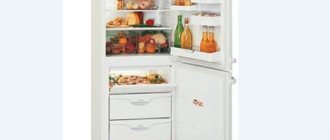The principle by which the defrosting system operates is a fundamental factor in choosing a refrigerator and freezer. The practicality of the entire device and the overall ease of use depend on it.
Until recently, manufacturers did not pay enough attention to the problem of the formation of large amounts of frozen condensate on the internal surfaces of refrigeration equipment. Such freezers often had to be turned off, wait for the frost and ice to melt, of which there could be a lot, and only then wash the inside of the chamber and put the device back into operation.
During the hot season, such manipulations had to be repeated several times a month, which took time and often caused food spoilage.
With the introduction to the market of models equipped with special systems to prevent the formation of ice in refrigerator compartments, such problems have become irrelevant.
What types of defrosting systems are there?
During operation, snow deposits and frost form in refrigeration equipment. Defrosting helps get rid of the problem. For the freezer compartment, manual defrosting and the No Frost system are used, for the refrigerator compartment - automatic (drip or No Frost). Older refrigerator models sometimes have manual technology.
Why do you need manual defrosting of the freezer?
Moisture from the air and food placed in the freezer accumulates on the walls and freezes, so frost and ice constantly form inside the chamber . If it does not have an automatic defrosting system, the unit is defrosted manually.
Defrosting is considered the main aspect of refrigeration equipment maintenance. What is manual defrosting of the freezer? To defrost the unit, it is disconnected from the network and freed from ice and snow through natural thawing. The water is removed, the equipment is washed and wiped.
If the chamber is not defrosted, the frozen layer begins to play the role of an insulator, since it has a lower heat transfer coefficient. As a result, the following problems arise:
- in older models of units, where the freezer is placed on top, the refrigerator compartment gradually freezes, which leads to spoilage of the food in it;
- if ice is ignored for a long time, the walls become covered with a thick layer of ice, as a result, the volume of the chamber decreases;
- the frozen layer slows down the cooling of the air, which changes the operating mode of the cooling system and leads to its overload;
- due to increased load, equipment wears out faster, the risk of failures and breakdowns increases, and the service life of household appliances is reduced;
- The operating time of the compressor increases, which increases energy consumption and leads to additional financial costs.
Ignoring ice in the freezer for a long time can lead to more serious consequences. As a result of the increased load, there is a risk of damage to the wiring and fire.
The procedure is carried out every 6 or 12 months, the frequency depends on the refrigerator model and operating conditions. If the unit is equipped with high-quality thermal protection, and the door is rarely opened, it is defrosted after a significant period of time. Old units with average use in winter are cleared of ice once every 3 months, in summer - once every 2 months.
Energy efficiency class
A refrigerator is an equipment that always works. Therefore, it is advisable to choose a model that consumes a small amount of electricity.
But when choosing, please note that the higher the energy efficiency class, the higher the price will be, and the difference is significant. Judge for yourself. Here are the prices for 2-chamber refrigerators, taken from one well-known online service for searching for equipment:
- A+++ price from $500:
- A++ - from $285;
- A+ - from $160.
If you don’t know how to choose a refrigerator so that it is economical, pay attention to energy efficiency
It is not worth taking household appliances below class A+ - they are too expensive to operate. And keep in mind that these are the simplest models in their class - with a minimum of bells and whistles and service functions.
What is automatic refrigerator defrosting and how does it differ from manual defrosting?
Next, we’ll tell you what it is—automatic defrosting of the refrigerator compartment. The first type is a drip system . It is used in most modern models and only in refrigerators. It is simple and effective. The evaporator (cooling element) is located behind the rear wall of the unit, with a drain installed underneath it. When the compressor operates, ice forms. When it stops working, the ice melts and the drops flow down the drain. From it, water flows into a special bath, which is located on the motor; there it evaporates. This happens gradually and imperceptibly.
The No Frost automatic refrigerator defrosting system is equipped only with the freezer or the refrigerator and freezer compartments - this depends on the model of the equipment. The evaporator is located behind the back wall of the unit or at the top of the freezer. A special fan is installed inside the chamber to ensure the movement of cold air. As a result, snow deposits do not form in it. Frost appears on the evaporator that is hidden from the user. Then the fan stops working and the heater turns on. Under its influence, the melted liquid flows into the pan along the grooves. There it evaporates.
Reference. Freezers with the No Frost system are gradually replacing standard models on the market. But they also have disadvantages. Unlike equipment with manual defrosting, they consume more electrical energy due to fan operation. A mechanism installed behind the rear wall reduces the chamber capacity by approximately 20 liters. Units with an automatic defrosting system are more expensive than conventional refrigerators.
Manufacturers of household appliances with the No Frost system recommend turning off the unit once a year for a day, leaving it with the door open. Since the ventilation, air supply and moisture removal systems are closed by the structure, ice may form there. By complying with this requirement, the user reduces the risks:
- premature failure of equipment;
- food spoilage due to incorrect temperature conditions;
- increasing electricity consumption.
Some models of modern refrigerators with manual defrosting are equipped with high-quality thermal insulation, which allows them to be defrosted once a year. Therefore, they are not inferior in ease of handling to equipment with the No Frost function, which is also recommended to defrost.
Climate class is important
This characteristic is rarely paid attention to. But in vain. It determines how well the refrigerator will cope with its tasks in hot weather. Moreover, how long it will work depends on this, since the same model of different climate classes is equipped with units of different power. This applies to both compressor power and refrigerant volume. One more point: if you buy a refrigerator of a lower class than you need due to weather conditions, you may be denied warranty repairs due to violation of operating rules. So before choosing a refrigerator for your home or garden, read this specification.
The climate class of a refrigerator shows at what temperature it should be operated. There are four classes, data on them is given in the table.
| International designation | Russian designation | Temperature | Notes |
| N | UHL | from +16°C to +32°C | In climates with not very hot summers, in heated rooms |
| SN | UHL | from +10°C to +32°C | In climates with not very hot summers, in unheated rooms (corridors, basements) |
| ST | from +18°C to +38°C | In hot climates (called subtropical class) or in southern rooms without air conditioning | |
| T | from +18°C to +43°C | In very hot climates (class called tropical) | |
| N-ST | mixed class | from +16°C to +38°C | higher maximum temperature |
| NT | mixed class | +16 to°C +43°C | Reduced lower temperature limit |
| SN-ST | mixed class | +10°C to +38°C | At high “summer” temperatures it has a low “winter” limit |
| SN-T | mixed class | +10°C to +43°C | Widest temperature range |
It’s easy to choose a refrigerator based on the temperature regime: you have an air conditioner and it easily keeps the kitchen cool, you can safely choose N - normal. There is no air conditioning, the climate is quite hot, or it is available, but does not always cope with the task - your choice is ST. Well, if you live in the south, you will need a T-class.
Recently, due to climate change, mixed classes have begun to be released. They have an extended temperature range. This is certainly good, but we remember that the wider the range, the more expensive the equipment. Although, these expenses are justified.
Please note that regardless of the class, a household refrigerator must operate at above-zero temperatures. They are not designed for frost. There is only one class - subnormal (SN), which can operate at +10°C. All others are designed for +18°C and not lower.
Where to look for the climate class of a refrigerator
The climate class is displayed on a nameplate pasted on the back of the refrigerator. There are usually Latin letters there, but on Russian-made units there may be Russian letters - UHL, which can be deciphered as a moderately cold climate.
Why manual defrosting of the freezer is a disadvantage
Automatic defrosting in the refrigerator occurs regularly. A freezer without a No Frost system is cleared of ice and snow manually.
There are models that have two temperature regulators - one for the freezer and the other for the refrigerator. In this case, it is possible to defrost the freezer compartment separately. To preserve frozen foods at this time, they are placed in the refrigerator. If there is only one regulator, the equipment is completely defrosted. The procedure is carried out 1-2 times a year, in older models more often - 1 time every 2-3 months.
Results
Comparing these two defrosting systems, it becomes clear that they both have their own advantages. Although No Frost is considered a more modern system, drip is also quite common today.
Of course, there are many more high-quality refrigerators than are presented in our rating, but you can definitely be sure of the models from the TOP: their reliability is assessed by both real buyers and experts. You just need to choose the best option for yourself in terms of size, capacity, cost and appearance.
Video - Drip system or No Frost?
How to defrost a refrigerator with a manual defrost system
Cleaning the refrigerator from ice and snow is carried out at room temperature. It is disconnected from the network, food is taken out of the chambers, containers and pieces of fabric are placed on the shelves in which melt water will accumulate. Wait for natural defrosting.
Large pieces of ice that fall off are thrown away. Then wash the unit with soapy water. The detergent must not contain chlorine, strong alkalis or acids. After the procedure, the surface is thoroughly wiped.
Advice. If you have free time, leave the equipment for 2-3 hours until moisture is completely removed from inaccessible places.
After drying, the products are returned to the shelves and the device is connected to the network.
In summer, minor glaciation thaws in 2-3 hours, more severe glaciation thaws in 6-8 hours. In winter or in a cool room, the process takes much longer. In order not to wait several hours for natural defrosting, accelerating procedures are used:
- They use heating devices - hair dryers, heaters, heat guns, etc., which are installed at a safe distance. The internal parts of the refrigerator are not designed to withstand high temperatures, so this method is used carefully. The permissible heating value is +60°C. To speed up the process, a fan is additionally installed.
- Blow with air at room temperature. This reduces the defrosting time by 2 times in the summer. A fan is used to create air flow.
- Plastic bottles with warm water and lids with holes are placed in the chamber. The method is effective and fast - the unit is cleared of ice in 10-15 minutes. Do not use boiling water.
- To defrost by steam, place several containers of hot water in the refrigerator and close the door. The larger the container and the higher the temperature of the liquid, the faster the process. To speed up the process, the water is periodically changed to hotter water.
Defrosting is carried out when the equipment is minimally loaded with food. To preserve them in cold weather, they are taken out to the balcony or placed in the cellar. When this is not possible or it is warm outside, other storage methods are used. For example, they wrap food in plastic bags, fold it tightly together and cover it with a warm blanket. In this way, a thermal insulation layer is created that will not allow them to thaw for several hours.
If it is possible to warm the products to the temperature of cold water, the bags are lowered into a container with liquid. It is desirable that it be flow-through. This is how fish, meat and semi-finished products are preserved. Ice is also used for storage. It is poured into a container, into which bags of food are then placed.
Important ! During defrosting, you should not break off the ice with your hands or use foreign objects - a knife, scraper, spatula, etc. The refrigerator body is not designed to withstand such loads. A small scratch can cause damage.











